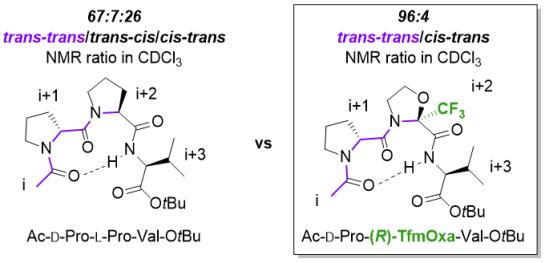
Proline is often found as a turn inducer in peptide or protein domains. Exploitation of its restricted conformational freedom led to the development of the D‐Pro‐L‐Pro (corresponding to (R)‐Pro–(S)‐Pro) segment as a “templating” unit, frequently used in the design of β‐hairpin peptidomimetics, in which conformational stability is, however, inherently linked to the cis–trans isomerization of the prolyl amide bonds. In this context, the stereoelectronic properties of the CF3 group can aid in conformational control. Herein, the impact of α‐trifluoromethylated proline analogues is examined for the design of enhanced β‐turn inducers. A theoretical conformational study permitted the dipeptide (R)‐Pro–(R)‐TfmOxa (TfmOxa: 2‐trifluoromethyloxazolidine‐2‐carboxylic acid) to be selected as a template with an increased trans–cis rotational energy barrier. NMR spectroscopic analysis of the Ac‐(R)‐Pro–(R)‐TfmOxa–(S)‐Val‐OtBu β‐turn model, obtained through an original synthetic pathway, validated the prevalence of a major trans–transconformer and indicated the presence of an internal hydrogen bond. Altogether, it was shown that the (R)‐Pro–(R)‐TfmOxa template fulfilled all crucial β‐turn‐inducer criteria.
Click here for publisher's page
